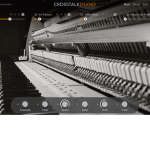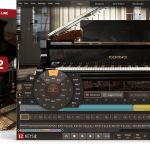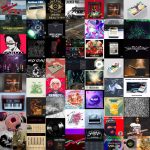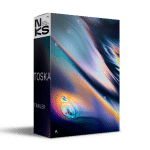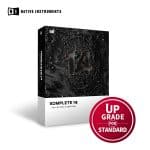Noisy Michael Unconventional Kontakt Bundle KONTAKT

HAMMERBASS
Hammerbass: its somewhere between a bass guitar and a hammered dulcimer. But don’t think the twee folky sound of a hammered dulcimer, but rather the jangly, noisy sound of hitting on your heavy-gauge roundwound GHS Boomers with a drumstick. Lots of character and body – great for bass, but also good in the higher register for more melodic uses. The Hammerbass has two sets of main samples (24-bit), one from a pickup and one close-mic’ed, with the mix being controllable from the custom interface. There are also separate samples for the attacks, for the note-off noises as well as for some string squeaks or scrapes (a noise like dragging a pick along a string). In addition, playing a high C triggers a “thud” sound like muting the strings on a bass. Multiple-velocity samples of course, and most samples have round-robin alternates. The custom interface provides controls for the amount of attack and for the volume of the characteristic note-off noises, and how often the “string scrape” noises are triggered between notes. You get two NKI instruments, the first where everything is combined and a custom script controls the triggering of note-off noises and scrapes, designed for just playing (this one was used for the Soundcloud demo) and the second where the main notes, note-off’s and scrapes are key-switched so you can have full control over when they get triggered.

MAX7IMBA
The Max7imba: Its somewhere between a Marimba, a Kalimba and a DX-7. Listen to the demo – its like a vacuum-tube marimba played with light-sabres. A metallic sort of percussive sound, but after the percussive hit, some drone voices come in and hang about for a bit, embedding the percussive main sound in a ghostly haze. This sample-set is based on an original DX-7 patch and the main samples have that non-linear DX-7 sound, sampled, of course, at multiple velocities. The mod-wheel brings in the drone voices. The drone voices are held for some time after you play the notes, so when you play a flurry of percussive notes, you are left with a long wash of drones. The custom interface has control for the length of the hold time. The drone voices have controllable vibrato. There is also a controllable attack sound (with round-robin alternate samples). A built in reverb and delay and an autophasing effect that adds subtle motion to your playing are all controllable from the custom interface.

NOSTROMO
Here’s the sound of the USCSS spaceship Nostromo, an M-class commercial mining starfreighter. This Kontakt instrument has a multi-layered spacey, analogy pad, to build your space-opera melodies with, combined with a selection of the grimy, clanky sounds of the spaceship itself: rumbles, HVAC systems, coolant pumps, and clanks echoing through the long metal corridors. Several Kontakt NKIs are included: you can have the pad and the spaceship noises as separate instruments, or mapped out for either a 88-key or a 61-key (5-ocatve) keyboard. The spaceship noises are on the lowest 11 notes and the pad above that. Special programming allows some of the spaceship noises to latch – you hit the key once and the spaceship rumble starts, and doesn’t stop till you hit the same key again, or untill you hit the lowest key, which kills all the drone voices at once. The custom interface provides volume controls for the various spaceship noises, a control for the latching behavior, and controls for the built-in chorus, reverb and delay effects.

GARLICK HARPSICHORD
Garlick Harpsichord: A lovely single-manual example, made by the renowned harpsichord-maker Andrew Garlick. Lovingly multi-sampled in great detail, including both notes and note-off samples. Controls are provided to bring in a second choir of strings, tuned an octave above the first, and for the volume of the note-off noises, as well as to control the amount of the built-in convolution reverb. If you want a little funky with your powdered wig, there is a “Filter” button, which turns on a resonant filter which is under the control of the mod-wheel.

TONGUE DRUM
The Tongue Drum. Also known as a slit drum, instruments of this type have been used throughout Africa, Southeast Asia and Oceania. Woody, percussive, melodic – its log, its log! This Kontakt instrument is deeply sampled, and made from close-miked stereo stereo samples, for a nice full sound. Unlike the real instrument, which only has six notes, the Kontakt instrument plays chromatically, and the range has been considerably extended so you can get some nice bass hits out of it. Sampled at multiple velocities, round-robin alternates. Included is a “gank” sound which is a strange squeak that happens when you hit the tongues hard and just a little bit crooked. This sound is controlled from the custom interface, so you can go from “perfect” playing to playing that has an organic grit to it (you can select full-time, random or none). The interface also provides a choice of neutral sound, or you can colour the sound with two convolution resonance modifiers (“wood” or “metal”).

JAW-HARP BASS
The Jaw-Harp Bass. A breathy, lamellophone bass sound built from a comprehensive set of jaw-harp samples. The difference to an actual jaw-harp is that this Kontakt-instrument can be played chromatically – so you can play melodies, bass-lines … symphonies no less. Multiple-velocity and round robin alternate samples of course. Samples in close-miked stereo for a nice wide sound. Modwheel fades between two different intonations. The custom interface provides controls for a “clanky” attack sound. The custom interface gives you control over a sub-bass which can be added, tone-colour, as well as the choice of two built-in reverbs and a built-in delay.

DX7 BASS
Here, celebrating the over 30-year history of one of the most popular synthsizers ever, is themost popular synthesizers ever, is the DX7 “electric bass” sound, one of the signature sounds from the DX7. This sound was everywhere in the early 80ies – think A-Ha “Take on Me”, Janet Jackson “When I think of You”, John Parr’s “St. Elmo’s Fire”, Kenny Loggins “Danger Zone” or Howard Jones “What is Love”, to name just a few. This sample-set is sampled direct from a 1983 brown battleship DX7 (original edition naturally), including the haze of digital distortion that you got from a 12-bit machine with 1983-level technology. Sampled at multiple velocities of course, to preserve the rich dynamics of the DX7. As ever, I give you more: a touch of a button brings in an extra pair of voices with controllable detuning for a fuller sound. The custom interface has controls for distortion and chorus, as well as allowing the selection of two amplifier impulse responses. The mod-wheel controls the amount of the built-in LFO, while its speed is controllable from the custom interface. Finally there is a “auto phasing” effect which adds a phasing effect, but rather than being cyclically modulated, this one changes with every new note to add a lot of motion to your playing

RUBBERBAND BASS
Hand me down my walking cane, and y’all had better prepare yourself, because you never heard a sound like the Rubberbandbass. When I saw this short fat guy Stretch a band between his toes, hey, I laughed so hard, cause the man got down! Sure, some people play $3000 Alembics or double-basses worth more than their cars. But sometimes, you ain’t got no cash and you just need to get down. That’s when you turn to the Rubberbandbass, its the bass for everyone! This is a multi-sampled rubber band, a nice fat purple one if you care, for that rubbery bass-sound. As ever, extensive controls are provided. There is a choice of three different impulse-responses, including two custom acoustic-sounding woody soundboards and a Tweed amp along with a “Tone” control to adjust the midrange. A built in LFO, controlled by the modwheel can go from adding a bit of grrrmph buzz to a rubbery wobble. Two-octave pitchbend – hey, this thing is stretchy – and a choice monophonic modes with legato or full-time glide or polyphonic, and finally a built-in delay. (Thanks to www.freesound.org, where user Alienistcog a.k.a. Chris Castiglione provided the extra twisty rubber-band noises, and Vincent Sermonne provided the brushed-drum track used on the demo, and to the Spinners for advertising copy)

VORSPRUNG DURCH TECHNIK
Vorsprung durch Technik [ˈfoːɐ̯ʃpʁʊŋ dʊɐ̯ç ˈtɛçnɪk] – a German vocal construction kit for when you need that Teutonic sound for your tracks. Who wouldn’t want, to quote Dylan Moran, a bit of “the sound of typewriters eating tin foil being kicked down the stairs” in their tracks? The sample-set has a selection of enigmatic words and phrases – each with round-robin alternates and recorded at different volume levels. Its an extensive set, with almost 200 individual samples. So your German robot voice can be expressive and emotive! The custom Kontakt interface provides controls for EQ as well as for the built in reverb and delay, and allows you to alter the pitch of the voice.

REESE CRUNCH
ReeseCrunch: a crunchy Reese machine, greasy like peanut-butter but cuts like a table-saw. Produces a reese-y bass sound, based on a triple sawtooth wave, so there is continuous movement as the three waves beat against each other. From there, there is an added layer of buzz which fades in an out randomly for extra movement, and then the whole thing is run through all kinds of further nonlinear nastiness. The custom Kontakt interface has a host of controls to tailor the sound to your depraved needs. There is a selectable “Attack” and a control for the sub-bass volume, the built-in filter, and the buzz volume, as well as built-in phaser and chorus effects, a choice of built-in delays, and of course the vital crunch (distortion) and selectable amp-simulator controls. You can also control the filter cutoff frequency using the mod-wheel to keep the sound moving, just like a proper reese. The soundcloud demo showcases only two of the myriad possibilities for tuning the sound.

SINEBASS
Sinebass: a pure sine-wave bass with a difference – you can keep going down and down and down! It works like this: for notes below a certain point, a subtle octave doubling starts to occur. Its like the foldback on a Hammond organ, except the effect is gradual. It means your bassline can go down and down and down, but still not fall off the bottom of what your speakers can reproduce. The point below which the foldback occurs is selectable, by note or frequency, so you can tune it for your computer speakers or your club bins. Check out the Soundcloud demo to see what it sounds like. The custom Kontakt interface allows you to select either a pure sine, or a waveshape with some second or some third harmonic content. There are three selectable types of attack (all three can be heard on the Soundcloud demo), as well as controls for the built-in saturation and chorus effects

JAM JAR
Another one from the kitchen: a tuned percussion instrument made from the sound of snapping a Mason jar lid. But that doesn’t tell you much – listen to the demo. Its somewhere between a steel drum and a kalimba. This very responsive Kontakt instrument has main samples at five different velocities as well as round-robin alternates. Tweakability is provided by the custom Kontakt interface, which has several controls to fine-tune the tone, and allows you to select a damped mode, where the notes end when the key is released, complete with note-off noises, or an undamped mode where each note rings to its natural conclusion. A “dubby” version of the instrument is also included, where the mod-wheel brings in a delay.

SAURUS
Here’s a complex, analogue resonant-filter sound for you. It consists of four separate layers, the two main ones providing a nice stereo sound with just enough detuning to make it fat, a separate sine-layer to make sure that the bass-oomph is always there, and a unique “buzz” layer, which is occasionally triggered to provide just a bit of rattle and buzz, so each note is a bit different. There’s a Kontakt script which implements a legato mode, much like most analog synths, where legato notes play without retriggering the sample or the filter envelope. A button controls whether its polyphonic or in legato mode, both modes can be heard on the demo. The mod-wheel is routed to the filter cutoff, and the Kontakt interface has knobs to allow other fiddlings, because this is a fiddling sort of sound!

DIRTYSYNC
DirtySync is an “Oscillator sync” sound, implemented using Kontakt programming and scripting. Since sampling technology is not well suited to oscillator-sync, brutally forcing Kontakt to do it results in a rich, gritty sound. If you want the digitally distressed version of Van Halens’ of “Why Can’t This Be Love” you’ve come to the right place! There is loads of control. The custom-scripted interface allows you to select the mod source to be either the Mod wheel, a built-in envelope with or without velocity sensitivity, with controllable decay rate. It also provides front-panel controls for the filter. Finally, the effects section includes switchable chorus, delay and bit-crushing effects.

MECHANALOG
A creaky, rather detuned “mechanical” synth, which makes its sounds with a Heath-Robinson sort of mechanism involving lots of tiny little gears and ratchets. The main samples are from my venerable Korg MS20 (not strictly speaking mechanical, but very definitely analog). In addition to these, there are grindy noises and Hammond-type keyclicks. Perfect for a grindy reese bassline, good for leads and for when you need that retro-funky but not-quite-adequately-lubricated disco sound. As usual, this patch is optimized for real-time playability: The mod-wheel goes to the filter cutoff, and key-pressure brings in vibrato. Pitch-bend is 2 octaves. The custom Kontakt panel has controls the amount of mechanical noise, pitch and amount of keyclick. .

SAMPLE AND HOLD
The sample and hold circuit: another standby from the analog synth era, propelled headlong into the digital present as a Kontakt instrument What was commonly called “sample and hold” was usually noise fed into a sample and hold circuit to produce stepped but randomly varying control voltages, which were then usually used to control the filter cutoff. Think “Rez” by Underworld or The Who’s “Won’t get fooled again”. This Kontakt instrument goes beyond that: the custom scripting produces a waveform that changes randomly in rhythmic steps. So you get a “sample & hold” effect but the filter is still free for whatever else you want to do with it! Of course, you can also route the stepped random control to the filter cutoff frequency to produce the traditional effect if you want, but you could instead control the filter with an envelope or with the mod-wheel – the possibilities are endless. What’s more, the “sample and hold” can either be free running, or can sync to your track’s BPM. This instrument can produce a wide variety of sounds – its virtually a full-blown synth VST all in its own! The Kontakt panel has a host of controls for the filter and waveshape and modulation – see the screenshot. Check out the Soundcloud demo for just three of the many possible sounds.

BONE FLUTE
The Bone Flute. A rare, 12,000 year-old example made from the thighbone of the Megatherium or Giant Ground Sloth. This Kontakt sampled instrument is designed for realistic flute lines: long main samples, a selection of different attack samples for various playing styles, and separate samples for wind noise. The custom Kontakt script allows realistic monophonic legato-playing. Real-time controls for breath, wind-noise, tremolo and octave-doubling are available through knobs provided by the Kontakt script or through Midi CCs. The Kontakt Bone-flute is lovingly programmed to provide a playing experience markedly superior to anything else available in the Paleolithic and even well into the Neolithic ages. (Truth in advertising disclaimer: okay, I made up the bit about the 12,000 years and the Megatherium; if you really need it to be, like, real – well maybe you shouldn’t be playing a sampler….)

SOPILA
A Sopila for Kontakt – an ancient, traditional, double-reed woodwind from Croatia (see http://www.gajde.com/index.php/en/sopile.html). This instrument is also known as the rozenice in Istria, and is very similar to the sopile from the island Krk. The samples are courtesy of Sameul Sacher (see http://www.samuelsacher.org). The samples are long and not looped. In addition to round-robin alternate samples, there special note-off breath samples as well as a trill sample. The sopile is a difficult instrument to play, and we have included a “flub” note, which can can be triggered at will to add character to your playing. The custom Kontakt interface has a button to make the instrument play monophonically – which makes legato notes sound more natural – as well as for the amount of pitch humanization, breath and wind noise, and for a built-in delay effect.

WIDE BEAM STUN
To achieve this big, way-stoned sound, this Kontakt instrument uses multiple phasers running at three different speeds: There is an instrument-level phaser but in addition, each voice has two different per-voice phasers. The Kontakt Interface has a control for the phaser-speed which simultaneously changes the speed of the three different LFO’s that control the swirly madness. The low end can be turned into an analogue-bass, also with controls on the interface. The mod-wheel fades from the full phaser to a crunched, band-pass filtered sound, and pitch-bend control does double duty to pitch-bend bass notes and low-pass filter the rest (listen to the Soundcloud demo, which involves only a single track, for examples).

BULBUL TARANG
Waves of Nightingales, my man! That is the literal meaning of Bulbul Tarang, which is the name of this Kontakt instrument. Also known as the Indian Banjo, it is a common folk instrument from India. The Bulbul Tarang has a two sets of strings, one for melody and one for drones. The melody strings are all tuned in unison and are fretted by keys, and played with a plectrum. This extensive sampleset has multiple-velocity samples with round-robin alternates, along with note-off samples, and separate samples for the drone strings. All samples decay naturally – no looping. It has a custom Kontakt script which reproduces the the monophonic response of the real instrument where lifting a key can cause the note to continue to ring at the root note produced by the open strings, with a selectable root-note. The script also allows you to choose a polyphonic mode.
Homepage:-http://bit.ly/2CuCYf4

![Initial Audio SLOWMO – HALFSPEED PLUGIN [WIN-MAC]](https://goaudio.me/wp-content/uploads/2018/12/Initial-Audio-SLOWMO-HALFSPEED-PLUGIN-crack-mac-60x60.png)








